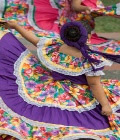Traditional Clothing for Women Costa Rica
For women in Costa Rica, traditional clothing consists of a dress tailored in a specific style to include a few important characteristics. Firstly the traditional dresses worn by women in Costa Rica on special occasions have thick and flamboyant ruffles protruding upwards and outwards from the shoulders and there are no sleeves to cover the arms. The most popular colors for traditional dresses in Costa Rica are all the bright colors including red, blue and yellow. Often, traditional dress in Costa Rica for women will consist of a long skirt that reaches down to the ankles made from shiny and colorful fabrics. From the waist upwards a plain white top is worn and these two items are brought together by a bright red cloth that is wrapped around the waist similar to a cummerbund. Often, a flower is artistically placed in the ear to top off this beautiful traditional costume for women in Costa Rica.
Traditional Clothing for Men Costa Rica
Traditional clothing for men in Costa Rica is simple yet elegant. Similar to the women, a traditional Costa Rican costume for men consists of a cummerbund, usually red in colour. This is accompanied by plain colored shirt and pants usually both white in color although this can vary. In addition a traditional Costa Rican costume for men will also include a straw cowboy type hat as well as a red scarf that is tied around the neck.
On a day to day basis, regular clothing in Costa Rica is more or less the same as you would find in America, consists of t-shirts and pants. One interesting point about clothing in Costa Rica is that despite the warm weather and tropical climate, men rarely walk around wearing shorts but prefer to wear pants. Costa Ricans tend to only wear shorts when going to the beach, although that doesn’t mean you should feel uncomfortable wearing shorts while in Costa Rica.
Posted by: Kasih Andaresta












